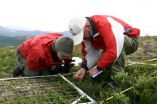(Press-News.org) Summertime hail could all but disappear from the eastern flank of Colorado's Rocky Mountains by 2070, according to a new modeling study by scientists from NOAA and several other institutions.
Less hail damage could be good news for gardeners and farmers, said Kelly Mahoney, Ph.D., lead author of the study and a postdoctoral scientist at NOAA's Earth System Research Laboratory in Boulder, Colo. But a shift from hail to rain can also mean more runoff, which could raise the risk of flash floods, she said.
"In this region of elevated terrain, hail may lessen the risk of flooding because it takes a while to melt," Mahoney said. "Decision makers may not want to count on that in the future."
For the new study, published this week in the journal Nature Climate Change, Mahoney and her colleagues used "downscaling" modeling techniques to try to understand how climate change might affect hail-producing weather patterns across Colorado.
The research focused on storms involving relatively small hailstones (up to pea-sized) on Colorado's Front Range, a region that stretches from the foothill communities of Colorado Springs, Denver and Fort Collins up to the Continental Divide. Colorado's most damaging hailstorms tend to occur further east and involve larger hailstones not examined in this study.
In the summer on the Front Range, precipitation commonly falls as hail above an elevation of 7,500 feet. Decision makers concerned about the safety of mountain dams and flood risk have been interested in how climate change may affect the amount and nature of precipitation in the region.
Mahoney and her colleagues began exploring that question with results from two existing climate models that assumed that levels of climate-warming greenhouse gases will continue to increase in the future (for instance, carbon dioxide, which is at about 390 parts per million today, increases in the model to 620 ppm by 2070).
But the weather processes that form hail – thunderstorm formation, for example – occur on much smaller scales than can be reproduced by global climate models. So the team "downscaled" the global model results twice: first to regional-scale models that can take regional topography and other details into account (this step was completed as part of the National Center for Atmospheric Research's North American Regional Climate Change Assessment Program). Then, the regional results were further downscaled to weather-scale models that can simulate the details of individual storms and even the in-cloud processes that create hail.
Finally, the team compared the hailstorms of the future (2041-2070) to those of the past (1971-2000) as captured by the same sets of downscaled models. Results were similar in experiments with both climate models.
"We found a near elimination of hail at the surface," Mahoney said.
In the future, increasingly intense storms may actually produce more hail inside clouds, the team found. However, because those relatively small hailstones fall through a warmer atmosphere, they melt quickly, falling as rain at the surface or evaporating back into the atmosphere. In some regions, simulated hail fell through an additional 1,500 feet (~450 meters) of above-freezing air in the future, compared to the past.
The research team also found evidence that extreme precipitation events across all of Colorado may become more extreme in the future, while changes in hail patterns may depend on hailstone size -- results that are being explored in more detail in ongoing work.
Mahoney's postdoctoral research was supported by the PACE program (Postdocs Applying Climate Expertise) administered by the University Corporation for Atmospheric Research and funded by NOAA, the Bureau of Reclamation and the Western Water Assessment. PACE connects young climate scientists with real-world problems such as those faced by water resource managers.
"With climate change, we are examining potential changes in the magnitude and character of precipitation at high elevations," said John England, Ph.D., flood hydrology specialist at the Bureau of Reclamation in Denver, Colo. "The Bureau of Reclamation will now take these scientific results and determine any implications for its facilities in the Front Range of Colorado."
INFORMATION:
NOAA's mission is to understand and predict changes in the Earth's environment, from the depths of the ocean to the surface of the sun, and to conserve and manage our coastal and marine resources. Join us on Facebook, Twitter and our other social media channels.
Co-authors of the new paper, "Changes in hail and flood risk in high-resolution simulations over the Colorado Mountains," include Michael Alexander (NOAA/Earth System Research Laboratory); Gregory Thompson (National Center for Atmospheric Research) and Joseph Barsugli and James Scott (NOAA/Cooperative Institute for Research in Environmental Sciences, CIRES).
Colorado mountain hail may disappear in a warmer future
NOAA-led study shows less hail, more rain in region's future, with possible increase in flood risk
2012-01-09
ELSE PRESS RELEASES FROM THIS DATE:
New test spots early signs of inherited metabolic disorders
2012-01-09
A team of scientists, led by researchers at the University of California, San Diego School of Medicine and Zacharon Pharmaceuticals, have developed a simple, reliable test for identifying biomarkers for mucopolysaccharidoses (MPS), a group of inherited metabolic disorders that are currently diagnosed in patients only after symptoms have become serious and the damage possibly irreversible.
The findings will be published online January 8 in the journal Nature Chemical Biology.
MPS is caused by the absence or malfunctioning of a lysosomal enzyme required to break down ...
Evolution of complexity recreated using 'molecular time travel'
2012-01-09
Much of what living cells do is carried out by "molecular machines" – physical complexes of specialized proteins working together to carry out some biological function. How the minute steps of evolution produced these constructions has long puzzled scientists, and provided a favorite target for creationists.
In a study published early online on Sunday, January 8, in Nature, a team of scientists from the University of Chicago and the University of Oregon demonstrate how just a few small, high-probability mutations increased the complexity of a molecular machine more than ...
Team finds a better way to gauge the climate costs of land use changes
2012-01-09
CHAMPAIGN, Ill. — Those making land use decisions to reduce the harmful effects of climate change have focused almost exclusively on greenhouse gases – analyzing, for example, how much carbon dioxide is released when a forest is cleared to grow crops. A new study in Nature Climate Change aims to present a more complete picture – to incorporate other characteristics of ecosystems that also influence climate.
"We know that forests store a lot of carbon and clearing a forest releases carbon dioxide into the atmosphere and contributes to climate change," said University of ...
Graphene reveals its magnetic personality
2012-01-09
In a report published in Nature Physics, they used graphene, the world's thinnest and strongest material, and made it magnetic.
Graphene is a sheet of carbon atoms arranged in a chicken wire structure. In its pristine state, it exhibits no signs of the conventional magnetism usually associated with such materials as iron or nickel.
Demonstrating its remarkable properties won Manchester researchers the Nobel Prize in Physics in 2010.
This latest research led by Dr Irina Grigorieva and Professor Sir Andre Geim (one of the Nobel prize recipients) could prove crucial ...
European mountain vegetation shows effects of warmer climate
2012-01-09
The decade from 2000 to 2009 was the warmest since global climate has been measured, and while localized studies have shown evidence of changes in mountain plant communities that reflect this warming trend, no study has yet taken a continental-scale view of the situation – until now.
With the publication of "Continent-wide response of mountain vegetation to climate change," scheduled for Advance Online Publication (AOP) in Nature Climate Change on 8 January, researchers from 13 countries report clear and statistically significant evidence of a continent-wide warming effect ...
EditCopyProof Launches Fresh Website Catering To Niche Copywriting Needs of Evolutionary Entrepreneurs
2012-01-09
Founder of EditCopyProof, Charlon Bobo, today announced the official launch of a new website featuring products and services specifically developed for evolutionary entrepreneurs. As one of only a few businesses worldwide addressing the specific needs of this market, Bobo is the only copywriter.
Affectionately known as the "conscious copywriter," Bobo enjoys the success of a worldwide clientele and a loyal following of evolutionary entrepreneurs; a quickly-emerging market. The term is a relatively new one, coming onto the business scene within the past year.
Evolutionary ...
2 genes affect anxiety, behavior in mice with too much MeCP2
2012-01-09
HOUSTON -- (Jan. 8, 2012) – The anxiety and behavioral issues associated with excess MeCP2 protein result from overexpression of two genes (Crh [corticotropin-releasing hormone] and Oprm 1 [mu-opioid receptor MOR 1]), which may point the way to treating these problems in patients with too much of the protein, said Baylor College of Medicine scientists in a report that appears online in the journal Nature Genetics.
Much of the work was done at the Jan and Dan L. Duncan Neurological Research Institute at Texas Children's Hospital.
MeCP2 is a "Goldilocks" in the protein ...
Global warming caused by greenhouse gases delays natural patterns of glaciation, researchers say
2012-01-09
GAINESVILLE, Fla. --- Unprecedented levels of greenhouse gases in the Earth's atmosphere are disrupting normal patterns of glaciation, according to a study co-authored by a University of Florida researcher and published online Jan. 8 in Nature Geoscience.
The Earth's current warm period that began about 11,000 years ago should give way to another ice age within about 1,500 years, according to accepted astronomical models. However, current levels of carbon dioxide are trapping too much heat in the atmosphere to allow the Earth to cool as it has in its prehistoric past ...
Mark Quiroz Hired as New Senior Pastor of First Evangelical Methodist Church of Glendora
2012-01-09
First Evangelical Methodist Church of Glendora is pleased to announce the official hiring of Mark Quiroz as their new Senior Pastor. He will be replacing the churches long time dedicated pastor Wenzel Sperl who passed away on September 26, 2011.
Pastor Quiroz brings to Glendora EMC, five years of church leadership as Youth Pastor of multiple churches. He graduated in 2011 with a Bachelors of Science Degree in Christian Ministry from Crown College in Minnesota. He is currently enrolled in the Master of Ministry program at Point Loma University in San Diego.
For more ...
Researchers discover new culprit in atherosclerosis
2012-01-09
A new study by NYU Langone Medical Center researchers identified a new culprit that leads to atherosclerosis, the accumulation of fat and cholesterol that hardens into plaque and narrows arteries. The research, published online by Nature Immunology on January 8, 2012, explains why cholesterol-laden, coronary artery disease-causing cells called macrophages, accumulate in artery plaques.
"We have discovered that macrophages that accumulate in plaques secrete a molecule called netrin-1," said Kathryn J. Moore, PhD, senior author of the study and associate professor in the ...
LAST 30 PRESS RELEASES:
The Ceramic Society of Japan’s Oxoate Ceramics Research Association launches new international book project
Heart-brain connection: international study reveals the role of the vagus nerve in keeping the heart young
Researchers identify Rb1 as a predictive biomarker for a new therapeutic strategy in some breast cancers
Survey reveals ethical gaps slowing AI adoption in pediatric surgery
Stimulant ADHD medications work differently than thought
AI overestimates how smart people are, according to HSE economists
HSE researchers create genome-wide map of quadruplexes
Scientists boost cell "powerhouses" to burn more calories
Automatic label checking: The missing step in making reliable medical AI
Low daily alcohol intake linked to 50% heightened mouth cancer risk in India
American Meteorological Society announces Rick Spinrad as 2026 President-Elect
Biomass-based carbon capture spotlighted in newly released global climate webinar recording
Illuminating invisible nano pollutants: advanced bioimaging tracks the full journey of emerging nanoscale contaminants in living systems
How does age affect recovery from spinal cord injury?
Novel AI tool offers prognosis for patients with head and neck cancer
Fathers’ microplastic exposure tied to their children’s metabolic problems
Research validates laboratory model for studying high-grade serous ovarian cancer
SIR 2026 delivers transformative breakthroughs in minimally invasive medicine to improve patient care
Stem Cell Reports most downloaded papers of 2025 highlight the breadth and impact of stem cell research
Oxford-led study estimates NHS spends around 3% of its primary and secondary care budget on the health impacts of heat and cold in England
A researcher’s long quest leads to a smart composite breakthrough
Urban wild bees act as “microbial sensors” of city health.
New study finds where you live affects recovery after a hip fracture
Forecasting the impact of fully automated vehicle adoption on US road traffic injuries
Alcohol-related hospitalizations from 2016 to 2022
Semaglutide and hospitalizations in patients with obesity and established cardiovascular disease
Researchers ‘listen in’ to embryo-mother interactions during implantation using a culture system replicating the womb lining
How changing your diet could help save the world
How to make AI truly scalable and reliable for real-time traffic assignment?
Beyond fragmented markets: A new framework for efficient and stable ride-pooling
[Press-News.org] Colorado mountain hail may disappear in a warmer futureNOAA-led study shows less hail, more rain in region's future, with possible increase in flood risk


